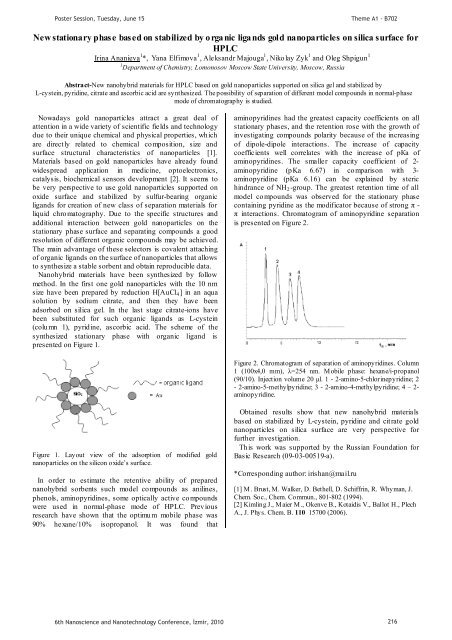Photonic crystals in biology
Photonic crystals in biology
Photonic crystals in biology
Create successful ePaper yourself
Turn your PDF publications into a flip-book with our unique Google optimized e-Paper software.
Poster Session, Tuesday, June 15<br />
Theme A1 - B702<br />
New stationary phase based on stabilized by o rga nic liga nds gold nanoparticles on silica surface for<br />
HPLC<br />
Ir<strong>in</strong>a Ananieva 1 *, Yana Elfimova 1 , Aleksandr Majouga 1 , Nikolay Zyk 1 and Oleg Shpigun 1<br />
1 Department of Chemistry, Lomonosov Moscow State University, Moscow, Russia<br />
Abstract-New nanohybrid materials for HPLC based on gold nanoparticles supported on silica gel and stabilized by<br />
L-cyste<strong>in</strong>, pyrid<strong>in</strong>e, citrate and ascorbic acid are synthesized. The possibility of separation of different model compounds <strong>in</strong> normal-phase<br />
mode of chromatography is studied.<br />
Nowadays gold nanoparticles attract a great deal of<br />
attention <strong>in</strong> a wide variety of scientific fields and technology<br />
due to their unique chemical and physical properties, which<br />
are directly related to chemical composition, size and<br />
surface structural characteristics of nanoparticles [1].<br />
Materials based on gold nanoparticles have already found<br />
widespread application <strong>in</strong> medic<strong>in</strong>e, optoelectronics,<br />
catalysis, biochemical sensors development [2]. It seems to<br />
be very perspective to use gold nanoparticles supported on<br />
oxide surface and stabilized by sulfur-bear<strong>in</strong>g organic<br />
ligands for creation of new class of separation materials for<br />
liquid chromatography. Due to the specific structures and<br />
additional <strong>in</strong>teraction between gold nanoparticles on the<br />
stationary phase surface and separat<strong>in</strong>g compounds a good<br />
resolution of different organic compounds may be achieved.<br />
The ma<strong>in</strong> advantage of these selectors is covalent attach<strong>in</strong>g<br />
of organic ligands on the surface of nanoparticles that allows<br />
to synthesize a stable sorbent and obta<strong>in</strong> reproducible data.<br />
Nanohybrid materials have been synthesized by follow<br />
method. In the first one gold nanoparticles with the 10 nm<br />
size have been prepared by reduction H[AuCl 4 ] <strong>in</strong> an aqua<br />
solution by sodium citrate, and then they have been<br />
adsorbed on silica gel. In the last stage citrate-ions have<br />
been substituted for such organic ligands as L-cyste<strong>in</strong><br />
(column 1), pyrid<strong>in</strong>e, ascorbic acid. The scheme of the<br />
synthesized stationary phase with organic ligand is<br />
presented on Figure 1.<br />
am<strong>in</strong>opyrid<strong>in</strong>es had the greatest capacity coefficients on all<br />
stationary phases, and the retention rose with the growth of<br />
<strong>in</strong>vestigat<strong>in</strong>g compounds polarity because of the <strong>in</strong>creas<strong>in</strong>g<br />
of dipole-dipole <strong>in</strong>teractions. The <strong>in</strong>crease of capacity<br />
coefficients well correlates with the <strong>in</strong>crease of of<br />
am<strong>in</strong>opyrid<strong>in</strong>es. The smaller capacity coefficient of 2-<br />
am<strong>in</strong>opyrid<strong>in</strong>e (pKa 6.67) <strong>in</strong> comparison with 3-<br />
am<strong>in</strong>opyrid<strong>in</strong>e (pKa 6.16) can be expla<strong>in</strong>ed by steric<br />
h<strong>in</strong>drance of NH 2 -group. The greatest retention time of all<br />
model compounds was observed for the stationary phase<br />
conta<strong>in</strong><strong>in</strong>g pyrid<strong>in</strong>e as the modificator because of strong -<br />
Chromatogram of am<strong>in</strong>opyrid<strong>in</strong>e separation<br />
is presented on Figure 2.<br />
Figure 2. Chromatogram of separation of am<strong>in</strong>opyrid<strong>in</strong>es. Column<br />
1 (1004,0 mm) . Mobile phase: hexane/i-propanol<br />
(90/10). Injection volume 20 l. 1 - 2-am<strong>in</strong>o-5-chlor<strong>in</strong>epyrid<strong>in</strong>e; 2<br />
- 2-am<strong>in</strong>o-5-methylpyrid<strong>in</strong>e; 3 - 2-am<strong>in</strong>o-4-methylpyrid<strong>in</strong>e; 4 – 2-<br />
am<strong>in</strong>opyrid<strong>in</strong>e.<br />
Figure 1. Layout view of the adsorption of modified gold<br />
nanoparticles on the silicon oxide’s surface.<br />
In order to estimate the retentive ability of prepared<br />
nanohybrid sorbents such model compounds as anil<strong>in</strong>es,<br />
phenols, am<strong>in</strong>opyrid<strong>in</strong>es, some optically active compounds<br />
were used <strong>in</strong> normal-phase mode of HPLC. Previous<br />
research have shown that the optimum mobile phase was<br />
90% hexane/10% isopropanol. It was found that<br />
Obta<strong>in</strong>ed results show that new nanohybrid materials<br />
based on stabilized by L-cyste<strong>in</strong>, pyrid<strong>in</strong>e and citrate gold<br />
nanoparticles on silica surface are very perspective for<br />
further <strong>in</strong>vestigation.<br />
This work was supported by the Russian Foundation for<br />
Basic Research (09-03-00519-).<br />
*Correspond<strong>in</strong>g author: irishan@mail.ru<br />
[1] M. Brust, M. Walker, D. Bethell, D. Schiffr<strong>in</strong>, R. Whyman, J.<br />
Chem. Soc., Chem. Commun., 801-802 (1994).<br />
[2] Kiml<strong>in</strong>g J., Maier M., Okenve B., Kotaidis V., Ballot H., Plech<br />
A., J. Phys. Chem. B. 110 15700 (2006).<br />
6th Nanoscience and Nanotechnology Conference, zmir, 2010 216













